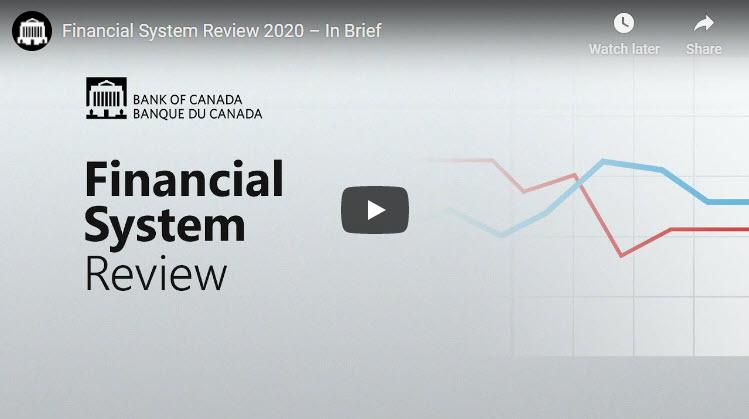
Financial system
Canada’s financial system has so far been resilient during the COVID‑19 crisis.
Uncertainty early in the pandemic led to a widespread flight to cash and made it hard to sell financial assets.1 The Bank responded by providing exceptional liquidity support to financial markets, as did other central banks around the world. These actions helped to address problems with market functioning and confidence, rapidly eliminating the effects of the liquidity shock.
Canada’s financial system has functioned well—helping Canadians weather the economic storm. And the financial system will play an important role in fostering a robust recovery.
Vulnerabilities and risks
In May, the Bank’s Financial System Review published timely and insightful assessments of vulnerabilities to the financial system. This work provided helpful information to support Canadians’ understanding of the COVID‑19 crisis.
In other research, Bank staff used new sources of microdata to identify business sectors and households2 that were most at risk of bankruptcy. They also assessed the extent to which income support programs and payment deferrals could help these sectors and households weather the economic crisis. Staff also used a newly developed top‑down stress‑testing framework3 to assess the potential resilience of Canadian banks4 under the worst‑case scenario outlined in the April Monetary Policy Report.5
Later in 2020, staff conducted further analysis and found that households were managing to keep up with their debt payments, but that an increasing number of businesses will likely need financing in 2021 to get by.6
ICYMI: Deputy Governor Schembri said the second phase of the economic recovery could be bumpy: after an initial bounceback, the speed, strength and breadth of recovery are harder to predict. #economy #COVID19 #cdnecon http://ow.ly/b03b50AbErj pic.twitter.com/1331341904181649408
— Bank of Canada (@bankofcanada) Nov 24, 2020

https://twitter.com/bankofcanada/status/1331341904181649408
Promoting financial system resilience
In response to the economic impacts of COVID‑19, the Bank launched several new and modified liquidity facilities and asset purchase programs. Their aim was to:
- keep markets functioning and credit flowing
- allow interest rate cuts to work their way through the economy
As part of its efforts to reinforce the strength of the financial system over the long term, the Bank signed agreements with prudential regulators in British Columbia, Alberta, New Brunswick, Nova Scotia and Ontario. These agreements enable the Bank to provide secured loans through the Standing Term Liquidity Facility (STLF) to provincially regulated financial institutions in these jurisdictions, as needed. And, thanks to an agreement signed with the Government of Quebec, the Bank can also provide emergency lending assistance to the Fédération des caisses Desjardins du Québec.
Oversight of financial market infrastructures
The Bank’s oversight activities supported the functioning of financial market infrastructures (FMIs) throughout the pandemic.7 During the initial phases of the crisis, Bank staff worked with provincial regulators to monitor how designated systems were operating in the challenging environment. This work resulted in important adjustments to some operational and risk practices.
Outside of its pandemic response, the Bank continued to make progress on longer‑term structural changes for FMIs, including:
- designating Interac e‑transfer as a prominent payment system
- establishing the FMI Resolution Committee to carry out the Bank’s responsibilities as resolution authority
- supporting the transition of the Automated Clearing Settlement System to a new technology platform
- conducting policy analysis, developing a supervisory approach and engaging payment service providers in anticipation of new responsibilities in retail payments supervision
Domestic partnerships
Throughout the year, the Bank worked with federal and provincial authorities to monitor and assess stress on individual banks and on the financial system. In 2020, the Bank:
- supported the Office of the Superintendent of Financial Institutions’ decision to adjust the Domestic Stability Buffer in March. This adjustment helped financial institutions to continue lending to businesses and households
- led the creation of the Systemic Risk Surveillance Committee8 (with both provincial and federal members) to help assess vulnerabilities in the financial system—including the pandemic’s impact on ongoing vulnerabilities (e.g., cyber security)
- worked with its partners in the Canadian Financial Sector Resiliency Group (CFRG)9 at the beginning of the pandemic to make it easier to share operational information—helping promote a better understanding of potential operational risks
- continued to support Payments Canada’s program to modernize the country’s core payment systems
In the Bank’s work with Payments Canada, it made progress on key aspects of both Lynx (the new high‑value payment system due to replace the Large Value Transfer System) and Real‑Time Rail (the new retail payments infrastructure that will support instant payments between individuals and businesses). While mandatory remote work and physical distancing protocols slowed progress at various participating agencies, both payment systems are scheduled to be launched over the next two years.
Interest rate benchmark reform
In June, the Bank became administrator of the Canadian Overnight Repo Rate Average (CORRA) and began publishing this Canadian interest rate benchmark on its website using an improved methodology. The Bank established the CORRA Advisory Group10 to provide advice on any potential adjustments to the methodology that might stem from changes in repo market functioning or from emerging issues.
With the anticipated discontinuation of the London Interbank Offered Rate (LIBOR), global financial markets are shifting more to overnight risk‑free rate benchmarks such as CORRA. The Bank fully supports the shift of the Canadian financial system to CORRA, which it expects to eventually become the primary Canadian interest rate benchmark. The Bank is actively working with industry stakeholders through the Canadian Alternative Reference Rate working group to facilitate this change, which now also includes a review of, and recommendations for, the Canadian Dollar Offered Rate (CDOR).
Financial stability and monetary policy
The Bank’s ongoing efforts to integrate financial stability concerns into monetary policy were accelerated by the COVID‑19 crisis. For instance, the Bank responded to the crisis by launching several liquidity support programs to restore market functioning, keep credit flowing and ensure the effective transmission of monetary policy.
Throughout the year, staff assessed the impacts of the Bank’s crisis response. The results, published on the Financial System Hub, will feed into the Bank’s work toward renewing its inflation‑control target agreement with the Government of Canada in 2021.
The Bank also made progress on its efforts to model the key links between financial stability and monetary policy decisions. With the next generation of monetary policy models, the Bank will be able to assess how, for example, house price expectations can amplify the boom and bust cycle.
The Bank’s efforts in this area were also supported by the newly created Heterogeneity Laboratory (HetLab). This is a collaborative online space where Bank researchers work on questions related to the role of variety in the circumstances of households and businesses (i.e., heterogeneity). Such work was critical to the Bank’s understanding of issues related to household savings and debt accumulation during the COVID‑19 crisis.11

https://www.youtube.com/watch?v=79rmc1QKWNQ
Looking forward
In 2021, the Bank will continue to:
- use microdata to monitor the effects of the pandemic on households and businesses, especially service‑oriented businesses directly affected by physical distancing measures
- work with industry to ensure that the trading and settlement of Government of Canada bonds continues to function smoothly in a low‑rate environment
- work with Payments Canada and financial institutions to enhance the resilience of the country’s wholesale payments system
- work with stakeholders and the Department of Finance Canada to prepare for the Bank’s new role overseeing retail payment service providers
- conduct research as part of the monetary policy framework renewal exercise related to the design and effective implementation of various monetary policy tools and to the role macroprudential policies play in complementing monetary policy
- incorporate financial stability considerations into monetary policy, including those arising from household heterogeneity
- 1. Bank of Canada, Financial System Review (May 2020).[←]
- 2. Olga Bilyk, Anson T. Y. Ho, Mikael Khan and Geneviève Vallée, “Household Indebtedness Risks in the Wake of COVID‑19,” Bank of Canada Staff Analytical Note No. 2020‑8 (June 2020).[←]
- 3. Thibaut Duprey, Xuezhi Liu, Cameron MacDonald, Maarten van Oordt, Sofia Priazhkina, Xiangjin Shen and Joshua Slive, “Modelling the Macrofinancial Effects of a House Price Correction in Canada,” Bank of Canada Staff Analytical Note No. 2018‑36 (November 2018).[←]
- 4. Bank of Canada, “The Financial System Remains Resilient,” Financial System Review (May 2020).[←]
- 5. Bank of Canada, Monetary Policy Report (April 2020).[←]
- 6. Toni Gravelle, “Taking the Pulse of Canada’s Financial System” (speech to Autorité des marchés financiers, Montréal, Quebec, November 23, 2020).[←]
- 7. Bank of Canada, “Regulatory Oversight of Designated Clearing and Settlement Systems.”[←]
- 8. Bank of Canada, “Box 1: Collaboration through the Heads of Regulatory Agencies,” Financial System Review (May 2020).[←]
- 9. Bank of Canada, “Bank of Canada Announces Partnership to Improve Resilience in Financial Sector,” press release (June 27, 2019).[←]
- 10. Bank of Canada, “CORRA Advisory Group.”[←]
- 11. James (Jim) C. MacGee, Thomas Michael Pugh and Kurt See, “The Heterogeneous Effects of COVID‑19 on Canadian Household Consumption, Debt and Savings,” Bank of Canada Staff Working Paper No. 2020‑51 (November 2020).[←]